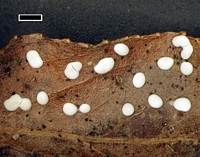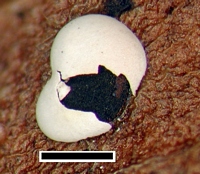|
 Didymium difforme Didymium difforme
SynonymsDiderma difforme
BiostatusPresent in region - Indigenous. Non endemic
Images (click to enlarge)
Caption: scale = 1mm
Owner: J.A. Cooper | 
Caption: scale = 0.25mm
Owner: J.A. Cooper |
Article: Stephenson, S.L. (2003). Myxomycetes of New Zealand. Fungi of New Zealand. Ngā Harore o Aotearoa 3: xiv + 238 p. Hong Kong: Fungal Diversity Press.
Description: Fruiting body a sessile sporangium, gregarious, flat-pulvinate, 0.1–0.3 mm tall and 0.3–1.0 mm broad, varying to short, netted or effused plasmodiocarps up to 25 mm in length. Hypothallus inconspicuous. Peridium double, the outer layer smooth, white, composed of densely aggregated lime crystals, sometimes lacking, the inner layer delicate, purplish or colourless, iridescent. Capillitium usually scanty, sometimes profuse, of brown or nearly colourless, dichotomously branching threads, often rather coarse below, slender above. Columella absent or represented by the purplish, thickened calcareous base. Spores black in mass, dark purple-brown or purplish grey by transmitted light, minutely warted, 11–14 µm in diameter, sometimes paler on one side. Plasmodium colourless or pale yellow.
Habitat: Dead leaves, other types of plant debris, and the dung of herbivorous animals.
Distribution: Cosmopolitan or nearly so (Martin & Alexopoulos 1969, Ing 1999). First reported from New Zealand by Cheesman & Lister (1915), but without naming a specific locality. Also known from Auckland, North Canterbury, and Dunedin (Rawson 1937).
Notes: The smooth outer layer of the peridium is more suggestive of a species of Diderma than Didymium, but the crystalline nature of the lime present is readily apparent when examined closely
|